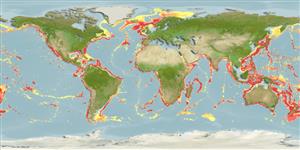Common names from other countries
Environment: milieu / climate zone / depth range / distribution range
Ecología
marino batidemersal; rango de profundidad 120 - 2000 m (Ref. 50610). Deep-water
Throughout the world ocean in tropical and temperate latitudes (Ref. 9842). Eastern Atlantic: one specimen from off Cape Bojador south of the Canary Islands; unrecorded specimens taken between Guinea and Angola. Western Atlantic: Canada (Ref. 5951) to the Gulf of Mexico (Ref. 29076). Western Indian Ocean: off Madagascar. Eastern Pacific: one specimen captured off northern central California, USA (Ref. 2850). Western Pacific: Japan to New Caledonia, Australia (Ref. 7300) and New Zealand (Ref. 5755).
Tamaño / Peso / Age
Maturity: Lm ? range ? - ? cm
Max length : 39.0 cm TL macho / no sexado; (Ref. 5951)
Short description
Claves de identificación | Morfología | Morfometría
Espinas dorsales (total) : 0; Radios blandos dorsales (total) : 19 - 22; Espinas anales: 0; Radios blandos anales: 15 - 18. Mouth large, maxillary extending far beyond eye (Ref. 559) Lower jaw projecting beyond the upper (Ref. 559). Teeth on both jaws broad villiform bands (Ref. 559). Body and each fin with minute spinules, the surface velvety to the touch. Lateral line opening as distinct pores (Ref. 559).
Juveniles mesopelagic, adults benthopelagic. Presumably feed on crustaceans.
Life cycle and mating behavior
Maturities | Reproducción | Spawnings | Egg(s) | Fecundities | Larva
Paxton, J.R. and D.J. Blake, 1990. Barbourisiidae. p. 606. In J.C. Quero, J.C. Hureau, C. Karrer, A. Post and L. Saldanha (eds.) Check-list of the fishes of the eastern tropical Atlantic (CLOFETA). JNICT, Lisbon, SEI, Paris; and UNESCO, Paris. Vol. 2. (Ref. 4500)
IUCN Red List Status (Ref. 130435)
CITES (Ref. 128078)
Not Evaluated
Threat to humans
Harmless
Human uses
Pesquerías: sin interés
Herramientas
Special reports
Download XML
Fuentes de Internet
Estimates based on models
Preferred temperature (Ref.
115969): 3 - 12.3, mean 7.1 (based on 2015 cells).
Phylogenetic diversity index (Ref.
82804): PD
50 = 1.5000 [Uniqueness, from 0.5 = low to 2.0 = high].
Bayesian length-weight: a=0.01122 (0.00514 - 0.02450), b=3.04 (2.87 - 3.21), in cm Total Length, based on all LWR estimates for this body shape (Ref.
93245).
Nivel trófico (Ref.
69278): 3.3 ±0.41 se; based on food items.
Fishing Vulnerability (Ref.
59153): Low to moderate vulnerability (29 of 100).
